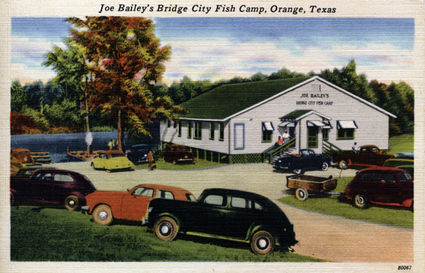Park service: Museum promotes heritage, tourism
Last updated 8/4/2010 at Noon
The Historical Museum of Bridge City board proposes to partner with the city to acquire and develop land to be used as a public waterfront park.
About five acres east of Texas 87 on Cow Bayou is owned by Orange County Development. The current price is $500,000. It was once the site of a popular fish camp – one of the community’s early establishments – owned by Joe Bailey.
“The location of the park, adjoining the Cow Bayou Swing Bridge – a National Register property – provides a unique and ideal advantage for cultural and heritage tourism,” museum board president Mark Dunn told city council members Tuesday.
“The Cow Bayou waterfront offers many recreational and natural resources available for residents and visitors,” he said. “Imagine the possibilities of turning the vacant Cow Bayou property into community assets for boating, fishing or quiet reflection; little known historic sites into attractive centers for recreation with displays, tours and events.”
Council members, while sympathetic with support, all agreed that money issues will likely present problems.
“It’s a wonderful idea,” said Councilman Eric Andrus. “It should have been done a long time ago.”
The museum has a grant writer, Dunn said, adding that various grants and other funding exists from various agencies including Texas Parks and Wildlife. Issues such as acquiring the property, deciding what to put there and how to manage it could be approached in phases.
“I believe there are a lot of corporate sources out there that would come in with us,” he said.
Debbie Gregg, an art teacher at Bridge City High School, said the park could include a playground, boardwalk, picnic tables, fishing areas and a city pond, and that farmers’ markets and other events could take place there. The grounds could also be home to restaurants and other businesses.
“The sky’s the limit as to what we could have in this park,” she said, adding that “seeing it from the [Cow Bayou] bridge and seeing it from the bayou,” would make it ideal for heritage tourism purposes.
“You’ve probably got support from all of us,” said Mayor Kirk Roccaforte. “As far as the city goes, it’s where the money’s going to come from. It’s a big dream. A lot of upkeep, a lot of oversight and a lot of money involved.”
The property has been vacant since the 1970s, Dunn said, when a fire destroyed the fish camp building. Maintenance and upkeep were definite issues, he said, however it is thought this can be balanced with tourism dollars.
“When people come to stay at the LaQuinta ... this would give them a place to go,” he said.
City Manager Jerry Jones and Parks Director David Rutledge agreed the city must own the property outright, for insurance purposes.
“Anytime a private organization tries to keep up insurance costs, it eats them alive,” Jones said. “The city’s insurance wouldn’t change that much [if it owned the land].”
A future meeting, time and place as yet unannounced, is slated between the property owners, city officials and museum board members.
The museum is a 501(c)(3) nonprofit organization. Contributions are tax deductible. The organization is also qualified to receive tax deductible bequests, devices, transfers and gifts as well as many grant and funding opportunities.
The museum board includes Claudine Hogan, executive director; Butch Thurman, vice president; Darrell Segur, historian; Paige Williams, secretary/treasurer; and board members Joe Chenella, Clark Slacum, Elaine Hearn, Joey Hargrave, Donna Riley, Leslie Barras and Lon Hubbard.
According to the Texas Historical Commission, Texas ranks second in the U.S. in the number of cultural and heritage travelers visiting the state – thus contributing to the state’s economy.













Reader Comments(0)